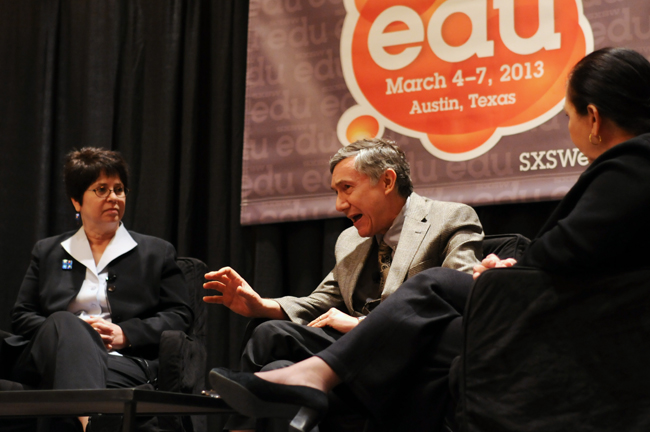Higher education institutions can graduate more students by shifting the landscape of college classes toward innovative technological learning models, according to a panel of higher education officials who spoke Tuesday, the second day of SXSWedu.
UT-Brownsville president Juliet Garcia and Steven Mintz, executive director of the UT System’s Institute for Transformational Learning, were part of a panel on teaching new educational methods to old colleges. They discussed integrating technology into the higher-education model and making changes to the roles of faculty members.
The panel was part of SXSWedu, a four-day event that hosts education panelists and speakers and is part of the annual South By Southwest conference and festival.
“When I advocate for online education, I’m not advocating for it instead of small seminars,” Mintz said. “I’m talking about courses like the ones I’ve taught with 592 students with no break out sessions, totally impersonal relationships between faculty and students and a 30 percent failure rate.”
The institute, which Mintz heads, was founded in 2012 as part of a System-wide initiative to enhance student learning in an innovative way and increase graduation rates.
Last October, the UT System Board of Regents voted to offer massive open online courses. Starting this fall, UT-Austin will pioneer this venture within the System and offer six free online courses through edX, a nonprofit distributor of interactive online courses.
Garcia said some faculty members are willing to use online platforms, adapt to technology in the classroom and accept their changing roles. This wave of technology also comes at a time when faculty who are resistant to change are retiring, according to Garcia.
“The most important thing is that no one’s job will look the same in a few years,” Garcia said. “It’s going to be uncomfortable for a while, but that’s okay.”
Mintz and Garcia also spoke about increasing graduation and retention rates by offering nontraditional courses.
Garcia said retention rates can be increased by finding programs that work well and scaling them up with technology that didn’t exist before.
UT-Brownsville currently partners with nearby high schools to offer a math and science pathway for high school juniors and seniors, but the program is limited to 140 students each year.
Garcia said technology can help increase this figure and reduce the time it takes these students to graduate.
Online interactive courses and accelerated courses that don’t fit into the 18-week course calendar can serve as solutions, Mintz said.
Mintz said 50 percent of UT-Austin students will fail at least one science course and 20 to 25 percent of students will “fail out” by the end of their second year.
UT-Austin spokeswoman Tara Doolittle said these figures only apply to those students who take six years to graduate.
More than 80 percent of students at the University graduate within six years, while about 50 percent graduate in four years.
Published on March 6, 2013 as "SXSWedu panel urges education innovation".





















